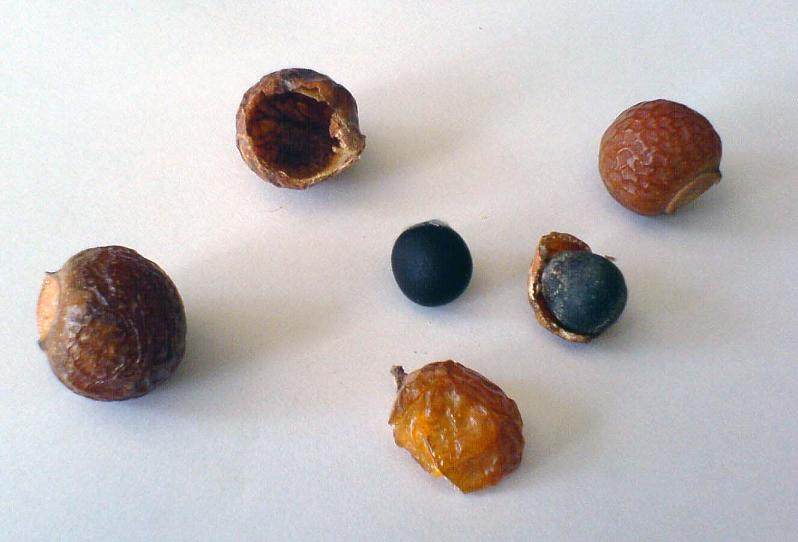I came across soapnuts (aka soapberries) a few years ago while searching for an alternative for harsh shampoos. I was really intrigued by the myriad of uses these “magical” berries supposedly had. They’re a renewable resource, cheaper than commercial cleaners, don’t contain unpronounceable additives and fragrances, they are antimicrobial and anti-fungal, and they are very gentle. Being gentle means they are not an equal replacement for commercial cleaners.
Soapnuts are the dried berries (or more accurately, drupes) from the Sapundus genus of trees. Varieties are found throughout Asia and the Southern USA to South America. The drupes contains a high level of saponins, which is a class of chemicals that can be used to create a soap-like foam. They have been used as a soap and medicinal by the indigenous people of those areas for centuries. Soapnuts from the Sapindus mukorossi tree contain the highest amount of saponins of all the Sapundus varieties.
Buying soapnuts
When purchasing soapnuts there are a number of things to look out for.
- Avoid “whole” berries. These generally contain seeds which adds to the weight of your purchase and are of no use for cleaning.
- Watch out for exaggerated claims, like saying you can get 30 loads of laundry done with just 6 berries.
- Soapnuts should be a golden or brown colour. If they are pale or greenish in colour they’ve likely been harvested too soon.
- They should be hard and dry to the touch. If they are pliable or moist they either haven’t been dried enough or gotten wet; neither of which are good.
Cleaning with soapnuts
I’ve done a lot of experimenting with soapnuts with varying degrees of success. The main reason I wanted to try them was as a shampoo. I have very fine, oily hair requiring daily washing and found even the gentlest shampoos hard on my hair. As a shampoo (I’ve included my recipe at the bottom of the page) it works wonderfully for me. My hair is much less brittle than with commercial shampoos. I don’t need to use conditioner when I use soapnuts because it doesn’t strip the hair like shampoo does and my hair is much less oily so it doesn’t have to be washed every day now.
I wish I could say every other use was as successful.
I had mixed luck washing my laundry with soapnuts. I tried using varying quantities of both soapnuts and soapnuts liquid and, while it was okay for my linens, I found it didn’t do a very good job of getting the smell out of clothes; the smell of sweat particularly. The soapnuts had to be used with washing soda to be able to take care of the smell. They also didn’t work on difficult stains. Those had to be pretreated.
Other Uses that worked well
- General household cleaner
- Dog shampoo
- Laundry, on lightly soiled linens and delicates, or with washing soda
- People shampoo and body wash
- Hand soap on non-greasy hands
- Insecticidal soap for aphids and mealy bug
- Carpet cleaner
Other Uses that didn’t work as well
- Glass cleaner. It was okay but vinegar works better.
- Laundry, when used alone
- Dishes
- Dishwasher
- Hand soap on greasy hands
- Jewellery cleaner
- Car wash
Conclusions
In general, soapnuts didn’t perform well with anything particularly greasy or smelly. The beauty of soapnuts is in how gently they clean.
There are some caveats.
- They do have a mild vinegary smell that some people may find unpleasant.
- Some people online make claims that soapnuts are antibacterial, antimicrobial, and antifungal. My reading found they are not antibacterial but they are effective against some microbes and fungi. They are however, definitely toxic to fish and other aquatic life.
- If using as an insecticidal soap on any edible plants be sure to wash them thoroughly before eating.
- Soapnuts can cause stomach upset if consumed. Also, like any soap, it will sting if you get it in your eyes.
Soapnuts shampoo recipe
- 5 soapnuts
- 3 cups of water
- Cooking pot
- Clean spray bottle
- Tight woven cloth or paper towel
- Strainer or colander
- Bowl
Bring soapnuts and water to a boil on the stove. Reduce the heat and simmer for 1/2 hour, then let cool. Put the strainer over a bowl. Line the strainer with a tight woven cloth or paper towel. Then strain the the liquid intothe bowl. Pour the liquid into spray bottle
To use, spray the soapnut shampoo onto your dry scalp and massage for at least one minute. You don’t need to spray your ends unless your hair is very long or very thick. Rinse and repeat if hair is very dirty
Notes: Soapnuts shampoo is very watery and doesn’t foam like commercial shampoos. It is the chemical reaction that cleans, not the foam. Soapnuts shampoo is not strong enough to remove oil treatments from hair. Since it contains no preservatives I only keep out enough for a week’s use and refrigerate the rest until I need it.

